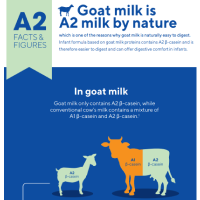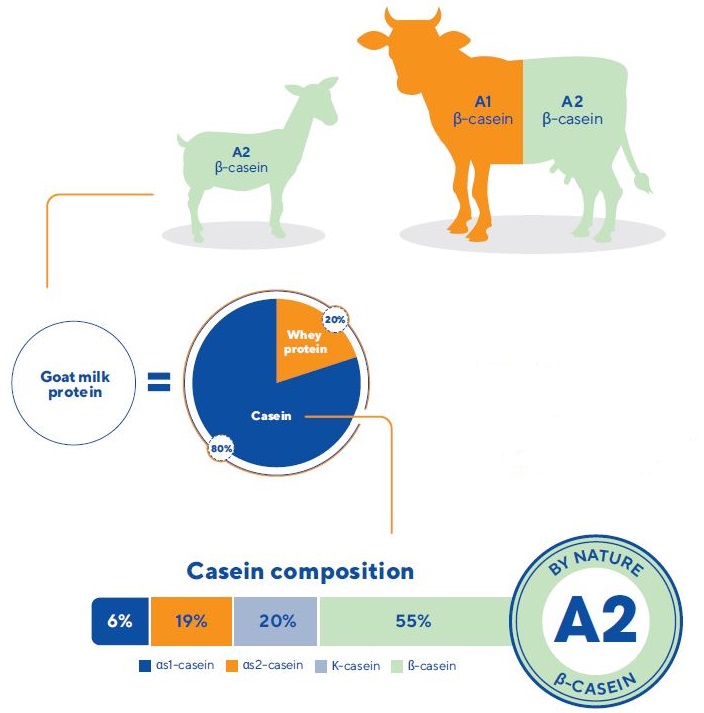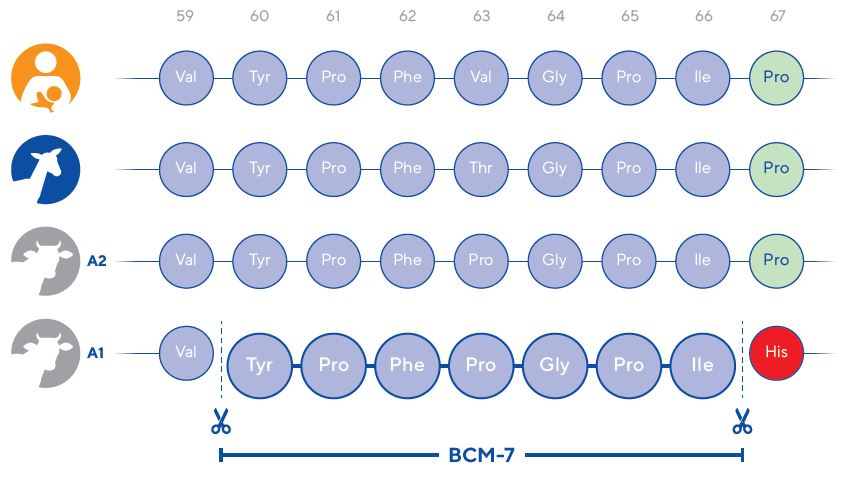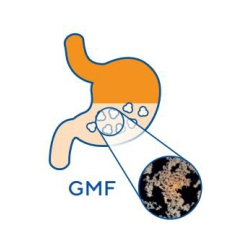
Kabrita is A2 milk by nature
The digestibility of Kabrita is also influenced by the type of β β-casein present in goat milk that is used to produce the formula. There are different variants of β-casein, which are said to have certain health consequences. In human milk and mammalian milk, there are two major β-casein variants, namely the A1 β-casein and the A2 β-casein.1 Digestion of these A1 or A2 β-casein variants generate different types of peptides, which consequently may have different impacts on the health of infants.

β-casein chains of human milk, goat milk, A2 cow’s milk and coventional a1 cow’s milk
β-casein consists of a chain of amino acids and different animal breeds have their unique sequence of amino acids. The main difference between A1 β-casein and A2 β-casein is the amino acid at position 67: A1 β-casein has histidine at position 67 and A2 β-casein has proline at this position.2 Human milk has proline at position 67 and is for this reason called A2 milk (since it contains the A2 β-casein). In goat milk, the β-casein also has proline at position 67 and can thus also be defined as A2 β-casein, so goat milk is also A2 milk (see figure 21).3-5 Conventional cow’s milk is A1 milk, as it contains a mix of A1 β-casein and A2 β-casein. In conventional A1 cow’s milk, the ratio of A1 to A2 β-casein is around 50:50.6 Cow’s milk with only A2 β-casein is known as A2 milk and comes from cows genetically selected to produce milk with only A2 β-casein. The β-casein of Kabrita formula has been analysed with validated analysis techniques7 by an ISO-certified laboratory (Eurofins). These analyses showed that all tested Kabrita formulas contain less than 0.01% A1 β-casein, demonstrating that Kabrita formula contains more than 99.99% A2 β-casein and can be called A2 milk (internal Eurofins report).

BCM-7 release from A1 β-casein and its digestive issues
β-casein will be digested in the stomach and the small intestine as enzymes cleave the amino acid chain into smaller peptides and amino acids. These peptides and amino acids can be absorbed and utilized by the body. If histidine is at position 67 (cow’s milk A1 β-casein), enzymatic cleavage happens just before histidine at position 67 and a seven amino acid peptide is formed, which is called cow’s milk β-casomorphin 7 (BCM-7). In A2 β-casein, proline is present at this position 67, which will hinder this enzymatic cleavage and thus the release of BCM-7.8
BCM-7 formed during the digestion of A1 cow’s milk is reported to potentially cause digestive symptoms in adults. BCM-7 activates opioid receptors that are expressed throughout the gut and in the body.9-11 Because A2 β-casein will not form BCM-7, these opioid receptors will not be activated and the negative effects on the body will not happen.5,12 Several health issues, mainly digestive issues, have been ascribed to BCM-7 formation during digestion of A1 cow’s milk. These health issues are mainly studied in adults or in animal experiments, and strong scientific proof is still lacking.

Gas production and abdominal pain
Clinical studies have shown that A1 cow’s milk delays the GI transit time leading to more gas production and abdominal pain. Adults consuming A1 cow’s milk experienced harder stools and had abdominal pain more often compared to adults consuming A2 cow’s milk.13 Similar results were shown in a randomized cross-over study including 40 women with self-reported dairy intolerance. Compared to A1 milk, A2 milk reduced GI complaints and improved lactose digestion in these lactose-intolerant women.14 He et al. performed a study with 600 adults with self-reported dairy intolerance and digestive issues like bloating and abdominal pain after the consumption of milk. The digestive symptoms were less severe after consumption of A2 cow’s milk than after consumption of A1 cow’s milk.6 A study with young children suffering from constipation (n=39, aged between 2 and 12 years) confirmed that A1 milk delays the GI transit time. Resolution of constipation was highest in children consuming A2 cow’s milk (79%) and lower (57%) in children consuming A1 cow’s milk, although this difference was not significant.15
Gut microbiota imbalance
BCM-7 activates the opioid receptors within the gut, consequently increasing mucin and mucus production.11,16 Excessive mucus production interferes with the gut microbiota and disrupts gastrointestinal functioning. Consumption of A2 milk can increase faecal short-chain fatty acid levels, showing beneficial effects on the gut microbiota.17
Increase inflammatory markers
A1 milk can increase inflammatory markers and in this way evoke inflammation.9 In a cross-over study, it was shown that the elimination of A1 milk reduced the inflammatory markers and consequently reduced GI symptoms (80 children, aged 5-6 years, with cow’s milk intolerance).18 Another study involving children showed that consumption of A1 milk increased faecal calprotectin levels, which is also a marker of intestinal inflammation.13
Allergic reaction
A2 β-casein is thought to be hypoallergenic and does not stimulate an allergic reaction. During an allergic reaction, TNFα and histamine are released. In laboratory testing, A2 milk did not stimulate histamine and TNFα release from human mast cells. 3,19
Check the infographic and video below for a quick overview of A2 goat milk.

Clinical study results
The clinical study results suggest that A1 milk can potentially lead to digestive issues such as hard stools, bloating and abdominal pain and that the intake of A2 milk prevents these issues. However, a systematic review described the effects of 15 randomized controlled studies investigating the health impact of A1 β-casein and concluded that the evidence only provides moderate certainty.10 Further infant studies comparing the health effects of A1 and A2 milk are warranted, as well as studies specifically focusing on A2 goat milk, as only A1 and A2 cow’s milk studies have been carried out so far.
In 2009, The European Food Safety Authority (EFSA) stated that BCM-7 can indeed have different effects on a person’s gut, such as effects on the gastrointestinal motility modulated via the opioid receptors. However, a cause-effect relationship between BCM-7 and any suggested non-communicable diseases cannot be established yet.
Conclusion
Kabrita formula is A2 milk by nature, as it contains only A2 β-casein and no A1 β-casein. A1 β-casein forms BCM-7 during digestion, which is thought to lead to digestive issues such as abdominal pain, hard stools and bloating. This makes Kabrita formula with A2 goat milk a good alternative for A1 cow’s milk-based formulas, maybe specifically for infants with cow’s milk intolerance.
References
- 1. Nilsen, H., et al., Casein haplotypes and their association with milk production traits in Norwegian Red cattle. Genet Sel Evol, 2009. 41(1): p. 24.
- 2. Farrell, H.M., Jr., et al., Nomenclature of the proteins of cows’ milk–sixth revision. J Dairy Sci, 2004. 87(6): p. 1641-74.
- 3. Jung, T.H., et al., Hypoallergenic and Physicochemical Properties of the A2 β-Casein Fractionof Goat Milk. Korean J Food Sci Anim Resour, 2017. 37(6): p. 940-947.
- 4. Hamosh, M., H. Hong, and P. Hamosh, milk B-casein derived opioid peptides. 2nd ed. Textbook of gastroenterology and Nutrition in Infancy. 1989, New York, USA: Raven press.
- 5. Pattanayak, S., Human health impact of bovine beta-casomorphin-7 of milk — A question for milk products or our breeding policy? Explor. Anim. Med. Res., 2013. 3(2): p. 2.
- 6. He, M., et al., Effects of cow’s milk beta-casein variants on symptoms of milk intolerance in Chinese adults: a multicentre, randomised controlled study. Nutr J, 2017. 16(1): p. 72.
- 7. Ehling, S., M. Wang, and L. Weber, Determination of total and A1-Type β-casein in milk and milk-derivedingredients by liquid chromatography – mass spectrometry using characteristic tryptic peptides. J AOAC Int, 2020.
- 8. Wada, Y. and B. Lönnerdal, Bioactive peptides released from in vitro digestion of human milk with or without pasteurization. Pediatr Res, 2015. 77(4): p. 546-53.
- 9. Pal, S., et al., Milk Intolerance, Beta-Casein and Lactose. Nutrients, 2015. 7(9): p. 7285-97.
- 10. Küllenberg de Gaudry, D., et al., Milk A1 β-casein and health-related outcomes in humans: a systematic review. Nutr Rev, 2019. 77(5): p. 278-306.
- 11. Zoghbi, S., et al., beta-Casomorphin-7 regulates the secretion and expression of gastrointestinal mucins through a mu-opioid pathway. Am J Physiol Gastrointest Liver Physiol, 2006. 290(6): p. G1105-13.
- 12. Clarke, A. and M. Trivedi, Bovine Beta Casein Variants: Implications to Human Nutrition and Health. 2014 International Conference on Food Security and Nutrition IPCBEE, 2014. 67(3): p. 6.
- 13. Ho, S., et al., Comparative effects of A1 versus A2 beta-casein on gastrointestinal measures: a blinded randomised cross-over pilot study. Eur J Clin Nutr, 2014. 68(9): p. 994-1000.
- 14 69. Milan, A.M., et al., Comparison of the impact of bovine milk β-casein variants on digestive comfort in females self-reporting dairy intolerance: a randomized controlled trial. Am J Clin Nutr, 2020. 111(1): p. 149-160.
- 15. Crowley, E.T., et al., Does milk cause constipation? A crossover dietary trial. Nutrients, 2013. 5(1): p. 253-66.
- 16. Claustre, J., et al., Effects of peptides derived from dietary proteins on mucus secretion in rat jejunum. Am J Physiol Gastrointest Liver Physiol, 2002. 283(3): p. G521-8.
- 17. Jianqin, S., et al., Effects of milk containing only A2 beta casein versus milk containing both A1 and A2 beta casein proteins on gastrointestinal physiology, symptoms of discomfort, and cognitive behavior of people with self-reported intolerance to traditional cows’ milk. Nutr J, 2016. 15: p. 35.
- 18. Sheng, X., et al., Effects of Conventional Milk Versus Milk Containing Only A2 β-Casein on Digestion in Chinese Children: A Randomized Study. J Pediatr Gastroenterol Nutr, 2019. 69(3): p. 375-382.
- 19. Kurek, M., et al., A naturally occurring opioid peptide from cow’s milk, beta-casomorphine-7, is a direct histamine releaser in man. Int Arch Allergy Immunol, 1992. 97(2): p. 115-20.75



